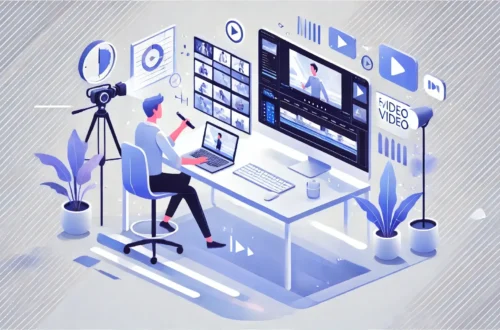In the fast-paced digital age, businesses need quick, engaging ways to capture attention and communicate their message effectively. Video has become one of the most powerful formats for marketing, training, and customer engagement. Yet, creating videos from scratch can often feel time-consuming and resource-heavy. This is where URL to video conversion comes into play—a method that enables companies to transform existing web content into dynamic video content with minimal effort.
By leveraging this approach, businesses can save valuable hours, streamline workflows, and repurpose content efficiently while maintaining consistency across platforms. Let’s explore how businesses can maximize productivity by using URL to video conversion.
What is URL to Video Conversion?
URL to video conversion is the process of turning a web page, article, blog, or any online content into a visually engaging video. Instead of starting from scratch, businesses can input a URL into a url to video converter, which automatically extracts text, images, and key points from the webpage and presents them in a video-friendly format.
Tools such as invideo and similar platforms offer this capability, allowing users to instantly convert their existing digital assets into professional-looking videos without needing advanced editing skills. For businesses, this means they can quickly adapt written content into video format to reach wider audiences who prefer consuming information visually.
Why Businesses Should Embrace URL to Video Conversion
1. Saving Precious Time
The biggest advantage is the time saved. Writing a script, sourcing visuals, and editing footage can take days, if not weeks. With a converter, most of this process is automated, cutting down production time drastically.
2. Repurposing Existing Content
Businesses already invest in blogs, reports, and case studies. URL to video conversion allows them to reuse this content, ensuring that one piece of work serves multiple purposes. A blog post can become a video explainer, or a product page can turn into a promotional clip.
3. Meeting Audience Preferences
Research consistently shows that audiences retain information better through videos than text. Turning webpages into videos helps businesses reach people who prefer visual learning or who are more likely to engage with video on platforms like YouTube, Instagram, or LinkedIn.
4. Consistency Across Channels
With a single URL, businesses can generate video content that stays true to their brand’s tone and message. This consistency helps maintain trust and authority across multiple platforms.
How URL to Video Conversion Saves Businesses Time
Automating Tedious Workflows
Traditionally, creating a video involves brainstorming, scripting, voiceovers, editing, and distribution. With a converter, much of this is handled automatically. The tool identifies relevant sections of the webpage, highlights visuals, and presents them in a polished sequence.
Faster Turnaround for Campaigns
Marketing campaigns often operate under tight deadlines. Instead of delaying launches due to lengthy video production cycles, URL to video conversion allows businesses to create supporting videos within hours, making campaigns more agile.
Reducing Reliance on Large Teams
Smaller businesses often lack dedicated video production teams. With conversion tools, a single marketer can handle video creation without needing graphic designers, editors, or animators. This independence saves not only time but also operational costs.
Practical Applications for Businesses
Marketing Campaigns
Marketers can turn blogs, press releases, and landing pages into short, engaging videos to be used across ads and social platforms.
Internal Training
Human resources and training teams can convert lengthy documents into easy-to-digest training videos. This reduces the time employees spend reading manuals and increases retention rates.
Customer Education
Product FAQs, user guides, and how-to articles can quickly be transformed into explainer videos, helping customers get answers without lengthy support interactions.
Sales Enablement
Sales teams can share video summaries of case studies, product features, or industry reports to impress prospects with visually compelling content.
Benefits Beyond Time-Saving
Increased Engagement
Video content typically receives higher engagement compared to static text. A single converted URL can generate videos that attract likes, shares, and comments, broadening reach.
Improved SEO Performance
Videos improve website ranking by increasing time spent on site and reducing bounce rates. By repurposing content into videos, businesses can improve their digital footprint without creating entirely new content from scratch.
Cost Efficiency
Time saved often translates into money saved. Businesses can reduce external production costs and allocate budgets more strategically, maximizing ROI.
Challenges Businesses May Face
Content Adaptability
Not all webpage content translates smoothly into video. Complex data-heavy articles may need additional adjustments to make the video more engaging.
Maintaining Brand Identity
Although automated, businesses need to ensure the converted videos match their brand’s voice, colors, and overall style to maintain authenticity.
Need for Human Oversight
While tools like invideo and other converters automate most processes, human oversight is essential to refine the output, ensuring accuracy and alignment with goals.
The Role of AI in URL to Video Conversion
AI plays a crucial role in powering these converters. From automatically selecting visuals and summarizing text to generating voiceovers, AI streamlines the entire process. Businesses can further benefit by combining this with AI video apps, which enable advanced editing, personalization, and customization. These apps often integrate features such as AI avatars, auto-subtitling, and scene suggestions, helping companies create polished videos in less time.
Best Practices for Businesses Using URL to Video Conversion
1. Choose the Right Content
Not every webpage should be converted. Select high-value content—such as top-performing blogs, FAQs, or landing pages—that can deliver impact in video format.
2. Refine the Script
Even though the tool automatically generates a script, review it for accuracy and tone. Editing ensures your message comes across clearly.
3. Customize Visuals and Branding
Add logos, brand colors, and style elements to maintain consistency and professionalism.
4. Optimize for Different Platforms
Adjust the video format for each platform—square for Instagram, vertical for TikTok, or widescreen for YouTube—to maximize engagement.
5. Add Subtitles and Voiceovers
Since many viewers watch videos without sound, subtitles are essential. AI-generated voiceovers can also help in reaching multilingual audiences.
Future of URL to Video Conversion
The future of business communication is video-first. As AI evolves, URL to video conversion will only become more intuitive, offering features like automatic scene transitions, better voice synthesis, and personalized branding at scale. Businesses that adopt these technologies early will have a competitive edge by producing high-quality video content faster and at lower costs.
Conclusion
In today’s competitive digital space, speed and efficiency are critical. URL to video conversion empowers businesses to repurpose existing content, cut down production time, and communicate more effectively with their audience. From marketing campaigns to internal training and customer support, the applications are endless.
By incorporating tools like invideo and exploring the possibilities of AI-driven solutions, businesses can harness the full potential of this method. The result? More engaging videos, less time spent on manual creation, and a streamlined path to achieving communication goals.


